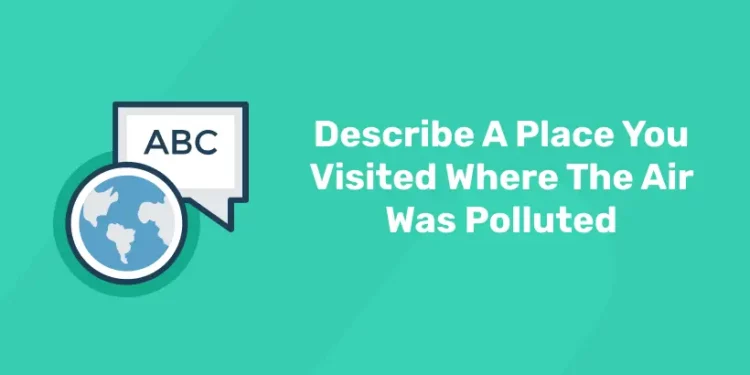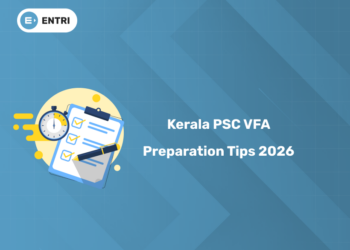Table of Contents
Speaking prompts or cue cards are crucial components of English language proficiency tests, particularly those that assess speaking skills, such as the IELTS. A broad range of speaking abilities, such as fluency, coherence, grammar, vocabulary, and pronunciation, are evaluated by these examinations. Examinees are frequently asked to explain experiences, goals, or occurrences in response to the “Describe” question type. A frequently encountered question on such cue cards is: “Describe A Place You Visited Where The Air Was Polluted.” This post will teach us how to specifically tackle this question.
Describe A Place You Visited Where The Air Was Polluted
Understanding the Question:
This question evaluates your proficiency in:
- Give a detailed description of a location and your observations in order to describe an experience.
- Environmental Awareness: Show that you are aware of the causes, impacts, and consequences of air pollution.
- Describe Your Own Impact: Tell us how the encounter changed your mental, physical, or emotional state.
- Provide Answers or Perspectives: Consider possible solutions to the problem, demonstrating a proactive and careful attitude.
Upon responding:
- Select a Place: Choose an area where air pollution was evident, like a city with a lot of industry or a building site.
- Describe the Pollution Source: Mention potential sources, such as industries, construction dust, automobile pollutants, or natural disasters like wildfires.
- Describe the Impact of Discuss outward symptoms (dust, haze), health effects (headaches, trouble breathing), or environmental effects (plant damage, decreased visibility).
- Give Your Own Perspective: Consider how the encounter made you more conscious of pollution and motivated any behavioral or mental adjustments.
How to Approach “Describe A Place You Visited Where The Air Was Polluted”
1: Most university students ........................ on campus in their first year.
When answering to this kind of cue card questions it is very important to create a well organized an thoughtful response.
Below give are some tips to approach this kind of questions.
Choose a Particular Location
- Select a place you have been to where there was noticeable air pollution, such as a large city, an industrial sector, or even a scene of a natural disaster.
- Make sure the option enables you to offer in-depth analysis and insights.
Describe the Visual Indications of Air Pollution:
- Talk about the conditions you saw, such as cloudy sky, poor visibility, or dust clouds.
- Describe the sensations of the contaminated air, such as a smokey odor, a scratchy throat, or difficulties breathing.
Describe the Causes
- Talk briefly on the probable causes of the pollution.
- Connect it to either natural (such as dust storms or wildfires) or manmade (such as car exhaust, industrial pollutants, or garbage burning) causes.
Discuss the Effects
- Talk about the impact of pollution on people, the environment, and yourself.
- Highlight health consequences (e.g., difficulty breathing, headaches) or environmental impacts (e.g., harm to plants or animals).
Reflect on the Experience
- Share your thoughts or feelings about the visit.
- Mention any steps or solutions you think are necessary to address air pollution.
Conclusion
Conclude by considering the significance of tackling pollution and how it has affected your attitude or actions.
Master the IELTS Exam with Online Coaching – Enroll Today!
Ace Your IELTS Exam with Confidence!
Unlock your potential with our expert-led IELTS preparation course. Achieve your dream score and open doors to global opportunities!
Start Your IELTS Journey Today!Structuring Your Answer: The Ideal Format for “Describe A Place You Visited Where The Air Was Polluted”
After discussing how to approach the cue card question, let’s move on to organizing your response in a way that makes sense and is obvious. Your answer’s structure is important since it makes it easier for the examiner to follow and comprehend your arguments.
Here is the perfect format for your response:
Introduction
- Indicate the location’s name clearly.
- Indicate the season, year, and event of your visit.
- Explain your visit in brief.
Description of the pollution
- Explain your observations, such as the haze, poor sight, and dusty surroundings.
- Talk about the sensations, such as burning eyes, itchy throat, and difficulty breathing.
- Emphasize the general atmosphere (e.g., dismal, oppressive).
Causes of pollution
- Give a brief explanation of the primary causes, such as industrial activities, crop burning, and car emissions.
- Add any regional or seasonal explanations (e.g., weather trapping pollutants, winter smog)
Effects of pollution
- Talk about the ways the inhabitants were managing, such as donning masks or staying indoors.
- Talk about any discomfort or negative health impacts you have personally experienced.
- Emphasize the effects of the pollution on the environment, such as the flora and the visibility.
Reflection on the experience
- Describe your feelings about the incident, such as shock or concern.
- Emphasize any knowledge or takeaways you may have gained around air pollution.
Conclusion
- Make suggestions for fixes or convey hope for progress.
- Talk about any resulting changes in your attitude or actions.
Example Answer: A Model Response for “Describe A Place You Visited Where The Air Was Polluted”
Introduction:
“Last winter, I traveled to New Delhi, the bustling capital of India, to attend a family wedding. While the city is renowned for its rich cultural heritage and historical landmarks, I was shocked by the poor air quality during my visit.”
Description of the Pollution:
“The air was heavy with smog, and the visibility was so low that distant buildings seemed to disappear into the haze. The sky looked dull and gray throughout the day, and there was a constant smell of smoke in the air. Within minutes of stepping outside, I felt a slight irritation in my throat and eyes.”
Causes of Pollution:
“I discovered that the primary causes of the pollution were emissions from the city’s heavy traffic, industrial activities, and the seasonal burning of crop stubble in nearby states. The cold weather had also created an inversion layer, trapping pollutants close to the ground and worsening the smog.”
Effects of Pollution:
“Many people were wearing masks, and I saw fewer pedestrians than usual for such a busy city. I noticed that even greenery in parks and along roadsides seemed coated in dust. Personally, I experienced mild respiratory discomfort and had to limit my outdoor activities.”
Reflection on the Experience:
“This visit was a wake-up call for me. It made me realize how significant an impact air pollution can have on both individuals and the environment. I gained a deeper understanding of the importance of collective action to tackle pollution and adopt sustainable practices.”
Conclusion:
“I hope that with better urban planning, stricter regulations, and public awareness, cities like New Delhi can overcome this challenge. This experience also motivated me to take personal steps, such as reducing my use of private vehicles and supporting eco-friendly initiatives.”
Tips for Practicing and Preparing for the ‘Describe’ Cue Cards
Practicing and preparing for “Describe” cue cards can improve your fluency, structure, and confidence when speaking. Here are some helpful tips to effectively prepare for these prompts:
Organize Your Response
- Stick to a simple structure: Introduction, Description, Personal Feelings, and Conclusion. This format helps keep your response organized.
- Practice using this structure for various topics to develop a natural flow.
Make Use of Essential Vocabulary and Expressions
- Gather vocabulary relevant to common topics (e.g., “Describe a place,” “Describe a person”).
- Learn some linking words like “moreover,” “as a result,” and “consequently” to make your speech cohesive and add complexity.
Use a Timer To Practice
- Set a timer for one to two minutes, as per the usual time limit, and practice speaking continuously within that time.
- This helps you pace yourself and trains you to expand or condense your response as needed.
Keep a Practice Log and Examine It
- Record yourself to identify areas for improvement, such as fluency, clarity, and coherence.
- Listen to your recording to catch filler words like “um” or “like,” and work on reducing them.
Prepare for Frequently Asked Questions
- Familiarize yourself with frequent cue card topics, such as “a memorable event,” “a challenging experience,” “a favorite hobby,” or “a person who inspires you.”
- Prepare short stories or experiences in your mind for each topic so you’re ready with examples.
Practice with Real-World Examples and Personal Narratives
- Examples and stories add depth to your answer and make it more engaging.
- When practicing, think of personal experiences that you can relate to a variety of prompts.
Put Fluency First Rather Than Perfection
- Aim to speak fluidly rather than worrying too much about grammatical perfection.
- Staying relaxed and talking naturally will improve your flow and make your speech sound more authentic.
Get Feedback
- If possible, get feedback from friends, teachers, or a language coach.
- Constructive criticism helps you recognize weak points and areas where you can improve.
Add “Why” and “How” to your response
- Anticipate follow-up questions that might ask “Why?” or “How?” and practice expanding your answer with reasons or explanations.
Use Pauses Cautionously
- Pausing for a moment between ideas helps you stay calm, think ahead, and sound more confident.
- Practice using natural pauses to break up ideas instead of rushing through.









